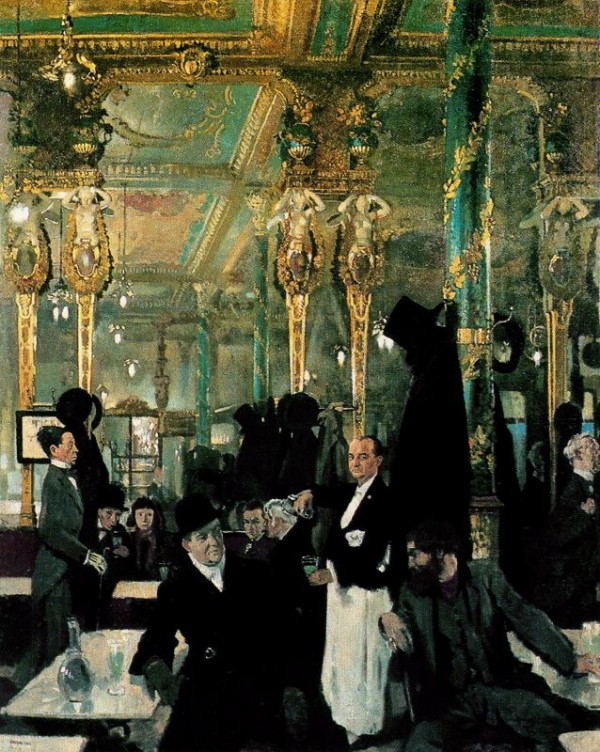“The Wine of Arabia”
The custom of drinking coffee was born in Yemen in the 15th century, but it’s not known how coffee reached the Arabian Peninsula.It is possible that Africans who migrated north from Ethiopia brought with them the seed plants they were accustomed to.The name “coffee” certainly derives from the Arabic word “qahwah”, which means “something that lightens moods and brings a certain sprightliness”.
Fairly soon, the wonderful drink spread throughout the Arab world.At the end of the 15th century, coffee reached Mecca and Cairo.The streets and bazaars were filled with sellers of the new drink, and soon the first cafes, called kaveh kanes, appeared.
For the Arabs, coffee became an alternative to the wine, forbidden by Muhammad, which was illegally sold in taverns.Respected members of society could be met over a coffee.However, some Islamic clerics were reluctant to accept the new drink.They argued that anything that causes physical or mental changes in those who consumed it should be prohibited by the Koran.One of the governors of Mecca, Khair Beg, banned the drinking of coffee completely for some time.This sparked a wave of opposition among the population, and the Khair was soon put to death.
English business over coffee
The first coffee house in Europe was opened in 1652 in Oxford by a man by the name of Jacob who came from the Middle East.The drink quickly captured the students and lecturers, and the number of cafes grew exponentially.They became a place of intellectual debate, and they began to be known as “penny universities” because anyone could go to them and, buying a cup of coffee for a penny, listen to the debates and discussions of the leading academics era, such as Christopher Wren, one of the founders of the Royal Society – the world’s oldest scientific society – and builder of London’s St. Paul’s Cathedral.
Remember also that the 17th and 18th centuries were a time when the press was blooming, and the cafes became a natural distribution network.Cafe owners often put up important economic information, prices, stock prices, and information on cargo ships arriving in London on noticeboards.Rapidly, individual premises began to specialize in a variety of industries depending on the clientele.To some came merchants; to others actors and musicians.And so, for example, merchants and entrepreneurs reigned in the cafes near the Royal Exchange.It might be said that today they’ve been replaced by offices and conference rooms.Londoners’ living relationship with cafes was so strong that the popular magazine “Tatler” named its individual sections after cafes.Poetry was discussed in “Will’s Coffee-house”, and science in “Grecian”.
London also launched the cheap, daily “penny post”.Coffeehouses were the addresses where couriers ran with letters.You could drop in for coffee and find out if something had arrived for you at the cafe’s address.
The story of Edward Lloyd is well known.In 1688 he opened a cafe on Tower Street in London.Edward’s customers were mainly shipowners, ship captains and merchants.He began to collect information about events at sea and cargos delivered to port and hung them on the bulletin board in his cafe.Then he hired messengers to bring the latest news from the docks – these services provided such reliable and up-to-the-minute data that financiers began to rely on it when insuring ships.Sometimes a ship’s insurance risk was too high for one person, so to share the risk a group of cafe regulars created a system of multiple insurers.And so it was that in that cafe one of the oldest and most famous insurance companies in the world, Lloyds of London, was born.
In 1762 a group of over 100 brokers proposed a system to the owner of Jonathan’s Coffee House.In return for a fee, they were to decide who could enter the premises and who not.They were sued by those “not allowed”, as a cafe is by definition a public place, and the court forbade such incidents.So they moved to a rented building, which to begin with was called “New Jonathan’s”, and after some time the “Stock Exchange”, which was the mother of today’s London Stock Exchange.
Cafes became places where opinion was shaped, and were somewhere between the home and the street.It should be noted that these public places were open to all (in London, as opposed to Paris, women were banned).Merchants, bankers and academics could all exchange their experiences.It happened that people of learning and business got along and set up companies engaged in producing inventions for the upcoming industrial revolution.
Liberty, Equality and Fraternity
The first French cafe opened in Marseilles in 1671.Just as in England, the custom of drinking coffee in company became very popular.In contrast to French salons, only frequented by the aristocracy, French cafes were open to all, regardless of gender and profession.Poets and philosophers met at Cafe Parnas and Cafe Procope.
Famous coffee addicts included:Rousseau, Diderot, Benjamin Franklin, Wolter. The latter supposedly drank 50 cups a day.
In Parisian cafes the ferment that occurred via the Enlightenment in the consciousness of society could be felt.The privileged aristocracy and the clergy had nothing to do with the new slogans of equality for all.French cafe guests did not, however, have as much freedom of expression as in London.The government strongly censored letters and listened in to café conversation.Discontent grew, and soon cafés became centres of revolutionary activity.At the outbreak of the revolution, there were 2000 of them!In them manifestos were read out, and the need for change and injustices were discussed.
The revolution began in the early afternoon at the Cafe de Foy on 12 July, 1789.Camille Desmoulins gave a fiery speech to the assembled crowd, from his table calling, “To arms, citizens!”.Two days later, the people of Paris stormed the Bastille.
In Poland, the first cafes were opened in Warsaw and inspired by Austria.The first opened near the Saxon Garden in 1724.
The text was prepared on the basis of and with the consent of the ekaloria.com website








